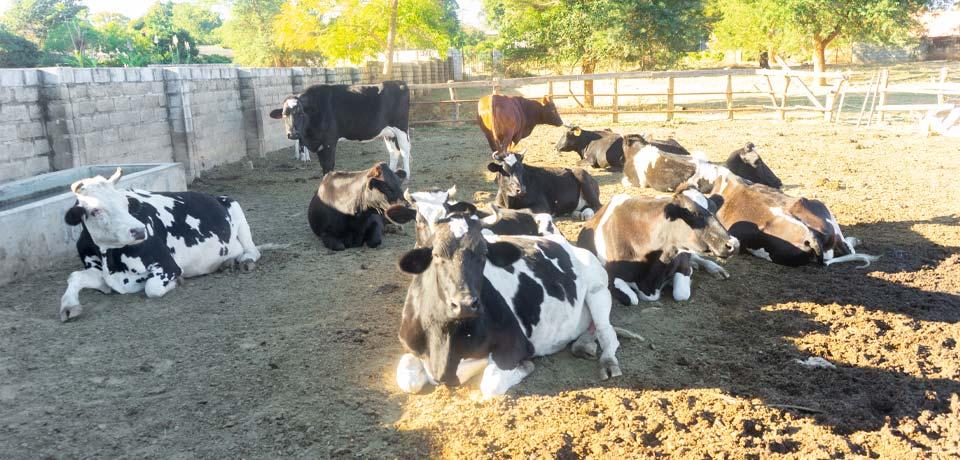
Priscilla Hamukwala, Rebecca. N. Kiwanuka-Lubinda, Edward M. Syampaku, Fahad Luttah Juma, Satu Määttänen & Eija Laitinen
The Zambian and Kenyan rapidly growing dairy sectors hold tremendous development and entrepreneurial potential that can be turned into employment opportunities, wealth creation, improved livelihoods and food security (Cheelo, 2019; Kawambwa et al., 2014; Mumba, 2012). The dairy sector provides nutritional sustenance both for rural and urban population (Cheelo, 2019), and employment beyond the production stage in processing and marketing (Nyameasem et al., 2018). The African agricultural sector is prioritized in absorbing most of the continent’s unemployed youth (African Union Commission, 2017), yet youth’s participation in the dairy sector remains low (Kawambwa et al., 2014; Neven et al., 2017). Preparing youths to solve the current dairy sector challenges — related mainly to low productivity, value addition, credit access and skills —, to exploit the sector’s arising opportunities, and to build a more dynamic and productive agri-food-system, requires a generation of entrepreneurial-minded problem-solvers and agro-entrepreneurs. Higher education institutions play a crucial role in this process by training agricultural professionals (Sherrard & Alvarado, 2017).
Challenges of Zambian and Kenyan dairy value chains
To understand the current challenges of the dairy sector, it is crucial to comprehend the dairy value chain with its various actors and operations (Figure 1).
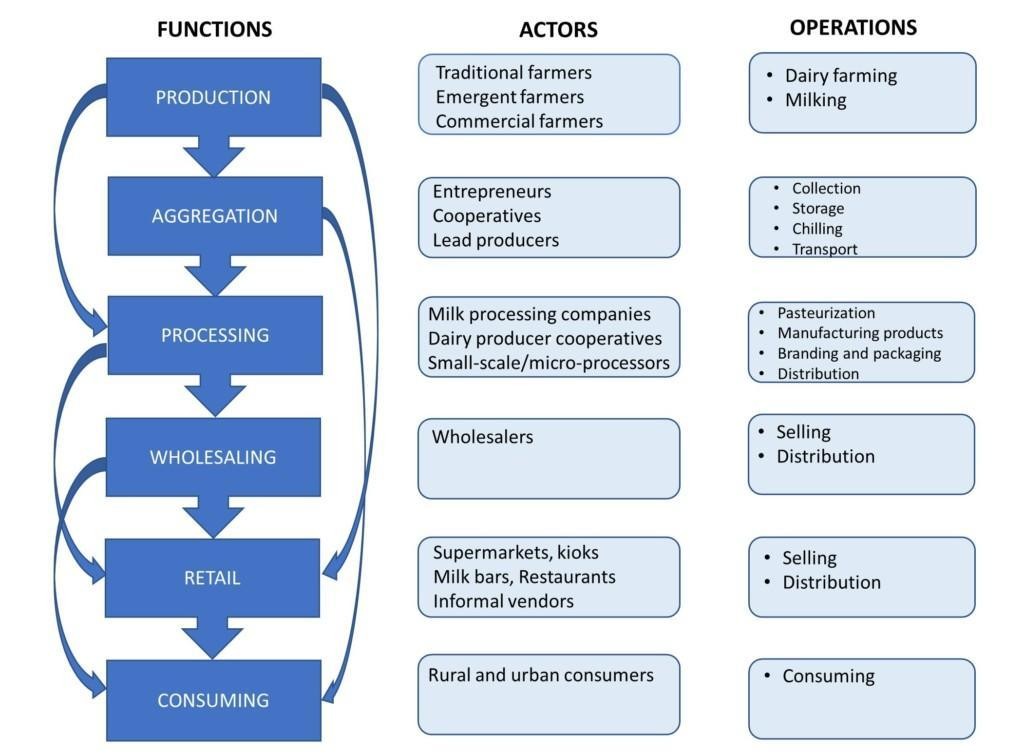
Dairy production in Zambia and Kenya is characterized by three producer groups, with different production goals, values and husbandry practices. Smallholder farmers own the majority of the cattle population, yet their milk productivity is very low and the bulk of production is used for their own consumption (Kawambwa et al., 2014; Odero-Waitituh, 2017). Commercial farmers, with improved breeds and management practices, reach ten times higher per animal productivity compared to smallholders (Nilsson & Chuzu, 2020). Emergent farmers display the elements of both traditional and commercial dairy farming (Kawambwa et al., 2014; Odero-Waitituh, 2017).
The main challenge of dairy production is low productivity, especially in Zambia where cattle density and productivity are much lower than in Kenya (FAOSTAT, 2019). Low productivity can be attributed to on-farm factors, such as the poor livestock disease management and low quality and quantity of feed, and socio-economic factors, such as high input costs, poorly targeted research and extension services, weak business environment and limited access to markets (Lubungu et al., 2016; Otieno et al., 2021). Only around half of the produced milk leaves the farm and enters the value chain, and an even smaller share reaches the high-priced formal markets, with the bulk of marketed milk being handled in informal markets (Mumba et al., 2013; Neven et al., 2017).
Milk aggregators add volume, and thus value to produced milk by aggregating milk from individual farmers for onward supply (Ndahetuye et al., 2020; Phiri et al., 2021). In Zambia, milk aggregators are often either producer cooperatives or emergent farmers, supplementing their production with purchases from smallholder farmers to attain market volumes (Mumba et al., 2013). Also, processing companies directly aggregate milk from farmers. Low primary production coupled with poor geographic networks and long collection and storage periods lead to high administrative costs for aggregators and compromised milk quality (Mumba, 2012). Moreover, aggregating milk from farmers with different cattle breeds and feeding systems leads to various milk quality characteristics (Hofer, 2015). Poor management and organizational skills in aggregator cooperatives reduce the potential for financing (Warlow & Kasabov, 2014), and causes problems for continuity (Ortmann & King, 2007).
Aggregators may sell collected and unpasteurized milk directly to consumers, or milk can be supplied to processors. Processors add value to milk, by refining: pasteurizing, packing and turning milk into other products, such as yoghurt and powdered milk (Nyokabi et al., 2018). Only a small share of milk produced reaches the value chain’s processing state and is sold through registered, formal, processors (Fintract, 2015).
Processors and producers supply dairy products to wholesalers and/or retailers. Retailers consist of a) fixed retailers, such as supermarkets and restaurants, b) milk dispersers, such as stand-alone businesses, c) vending machines, and d) informal vendors, acting as a link between farmers and consumers (Birachi, 2006; FAO, 2011). In Kenya, more than a four-fifth of marketed milk is sold within the informal sector (Kaitibie et al., 2010).
Most of the milk produced is channelled to consumers through informal markets without processing or retail licensing (Blackmore et al., 2015), limiting the value addition and the sector’s development. Moreover, the lack of quality assurance within the informal channel poses potential health risks to consumers.
At the endpoint of the dairy value chain, there are consumers, with the annual per capita milk consumption (~18 litres in Zambia and 110 litres in Kenya) (Njeru, 2022; Zhang et al., 2016), still far below the FAO recommendation of 200 litres (Pandey, 2010). However, studies indicate that urbanization and growing incomes are increasing milk consumption (Namonje-Kapembwa & Hichaambwa, 2016; Resti et al., 2017), and urban consumers tend to prefer formal value chain channels (Neven et al., 2017). This demonstrates the relative importance of the formal value chain in stimulating dairy demand.
Competences needed to deal with the dairy value chain challenges
Rapid changes in socio-economic structure and agricultural practices call for not only content knowledge, but also knowledge application and transferable 21st century skills. The core skills that future dairy professionals need, to be able to solve the dairy sector challenges, add value to the sector, and keep up with the changing working environment include:
- Technical skills
- Breeding for milk quantity and quality
- Dairy animal feeding
- Disease management
- Milk quality maintenance
- Cognitive skills
- Critical and creative thinking
- Risk mapping
- Recognition of alternative solutions
- Methodological skills
- Milking skills
- Milk quality assessment
- Problem-solving
- Decision making
- Financial management
- Risk management
- Marketing
- Social skills
- Teamwork
- Management and leadership
- Communication
- Conflict management
- Value chain actor integration
Combinations of these skills give rise to competencies that can be utilized to solve the current dairy sector challenges, develop the sector, and grasp arising opportunities.
Role of universities in developing core competencies
As described in the Zambian and Kenyan Visions 2030, the education and training of citizens will provide grounds for diversifying agriculture and the economy as a whole, thus creating employment and well-being. However, there is a consensus in Africa that graduates from higher education institutions lack the competencies demanded by the dairy sector. This creates a major concern for the wage and self-employment of graduates, as well as dairy sector development. Part of the solution to this problem is to reassess the methods used to impart knowledge and skills to students.
Agricultural education in Zambia and Kenya relies on conventional, teacher-centered methods where students are passive recipients of information, with low information retention and application skills (Troussas et al., 2020). An alternative to the conventional method is problem-based learning (PBL) which enhances learning through active student participation and practical, real-life problem-solving (Barrows, 1985). Compared with conventional methods, PBL is argued to more likely produce motivated students with improved critical thinking, decision-making, problem-solving, reasoning, comprehension, retention and application skills (Richardson, 2003). Many scholars have attested to the importance of PBL in applied sciences such as agriculture.
Agricultural syllabi in Zambia and Kenya could be adjusted to include the PBL methods. Agricultural and dairy students could participate in projects, where they, together with dairy sector actors and stakeholders, identify value chain challenges, and find and propose solutions to them. This would lead to synergistic outputs with improved learning outcomes and practical experiences for students, and assistance for value chain actors to overcome their challenges, subsequently, improving the whole dairy sector.
This article has been written as part of a professional Problem-Based Learning Training Programme for East and Southern African university teachers. The training programme was organized as part of AgriSCALE project (https://www.agriscale.net/) activities during 2021. AgriSCALE is an EU-funded project coordinated by Häme University of Applied Sciences (FIN), that aims to reform agricultural education and curricula in East and Southern African universities. Project partners include nine universities from East and Southern Africa and Europe.
Authors
Priscilla Hamukwala, PhD, Lecturer, Department of Agricultural Economics and Extension, University of Zambia.
Rebecca. N. Kiwanuka-Lubinda, PhD, Lecturer Department of Agricultural Economics and Extension, University of Zambia.
Edward M. Syampaku, MSc. Lecturer & researcher, Mulungushi University
Fahad Luttah Juma, MSc Agribusiness Management, Egerton University.
Satu Määttänen, M.Sc, Research assistant, Häme University of Applied Sciences
Eija Laitinen, PhD, Principal Research Scientist, Leader of HAMK Africa Team, Häme University of Applied Sciences
References
African Union Commission. (2017). African Union roadmap on harnessing the demographic dividend through investments in youth. https://addis.unfpa.org/en/publications/au-roadmap-harnessingthe-demographic-dividendthrough-investmentsin-youth-0
Barrows, H. (1985). How to Design a Problem-Based Curriculum for the Preclinical Years. Springer.
Birachi, E. (2006). Determinants of coordination and supply chain performance The case of fresh milk supply chains in Kenya [The University of Kiel]. https://macau.uni-kiel.de/receive/diss_mods_00001826
Blackmore, E., Alonso, S., & Grace, D. (2015). Legitimising informal markets: a case study of the dairy sector in Kenya. https://www.jstor.org/stable/resrep29043
Cheelo, T. (2019). Milk production and marketing channel decisions of smallholder farmers in the Zambian milk value chain [University of Pretoria]. https://repository.up.ac.za/handle/2263/72638
FAO. (2011). Dairy Development in Kenya by H.G. Muriuki.
FAOSTAT. (2019). FAOSTAT Statistical database. Food and Agriculture Data. https://www.fao.org/faostat/en/#home
Fintract. (2015). Kenya agricultural value chain enterprises: quarterly report #12: October – December 2015. https://pdf.usaid.gov/pdf_docs/PA00MSX3.pdf
Hofer, A. (2015). Small scale dairy farming in Zambia [Swedish University of Agricultural Sciences]. https://stud.epsilon.slu.se/8066/7/hofer_a_150617.pdf
Kaitibie, S., Omore, A., Rich, K., & Kristjanson, P. (2010). Kenyan Dairy Policy Change: Influence Pathways and Economic Impacts. World Development, 38(10), 1494–1505. https://doi.org/10.1016/j.worlddev.2010.06.008
Kawambwa, P., Hendriksen, G., Zandinda, E., & Wanga, L. (2014). Business Viability assessment study of small holder dairy farming in Zambia. https://agriprofocus.com/upload/Business_Viability_assessment_study_of_small_holder_dairy_farming_in_Zambia1425011596.pdf
Lubungu, M., Sitko, N. J., & Hichaambwa, M. (2016). Factors Limiting Smallholder Cattle Commercialization in Zambia. Food Security Collaborative Policy Briefs, 234946. https://doi.org/10.13140/RG.2.2.27878.01607
Mumba, C. (2012). Economic Analysis of the Viability of Small Holder Farming in Zambia [The University of Zambia]. http://dspace.unza.zm/handle/123456789/1804
Mumba, C., Pandey, G. ., & van der Jagt, C. (2013). Milk production potential, marketing and income opportunities in key traditional cattle keeping areas of Zambia. Livestock Research for Rural Development, 25(4). http://www.lrrd.org/lrrd25/4/mumb25073.htm
Namonje-Kapembwa, T., & Hichaambwa, M. (2016). Assessing Opportunities and Challenges for Youth Employment in the Dairy Value Chain in Zambia.
Ndahetuye, J. B., Artursson, K., Båge, R., Ingabire, A., Karege, C., Djangwani, J., Nyman, A. K., Ongol, M. P., Tukei, M., & Persson, Y. (2020). MILK Symposium review: Microbiological quality and safety of milk from farm to milk collection centers in Rwanda. Journal of Dairy Science, 103(11), 9730–9739. https://doi.org/10.3168/JDS.2020-18302
Neven, D., Reardon, T., Hernandez, R., & Tembo, G. (2017). Smallholder farmer participation in a modernizing food system: insights from the dairy value chain in Zambia. https://www.cabdirect.org/cabdirect/abstract/20183167962
Nilsson, Å., & Chuzu, P. (2020). Project Review of the Dairy Association of Zambia (DAZ)’s Digital Information Management System (DIMS) project. https://www.sida.se/en/publications/project-review-of-the-dairy-association-of-zambia-dazs-digital-information-management-system-dims-project
Njeru, T. N. (2022). Kenya’s dairy sector is failing to meet domestic demand. How it can raise its game. The Conversation, Africa Inc. https://theconversation.com/kenyas-dairy-sector-is-failing-to-meet-domestic-demand-how-it-can-raise-its-game-176017
Nyameasem, J. K., Reinsch, T., Malish, C., & Taube, F. (2018). The potential of dairy production in sub-Saharan Africa. https://www.lfl.bayern.de/mam/cms07/ipz/dateien/aggf_2018_nyameasem_et_al.pdf
Nyokabi, S., Oosting, S. J., Bebe, B. O., Phelan, L., Bett, B., Lindahl, J., & Boer, I. J. M. de. (2018). The Kenyan dairy sector: stakeholder roles and relationships, and their impact on milk quality. Farming Systems: Facing Uncertainties and Enhancing Opportunities (European IFSA Symposium), 6. https://library.wur.nl/WebQuery/wurpubs/539884
Odero-Waitituh. (2017). Smallholder dairy production in Kenya: a review. Livestock Research for Rural Development, 29(7). http://www.lrrd.org/lrrd29/7/atiw29139.html
Ortmann, G. F., & King, R. P. (2007). Agricultural cooperatives II: Can they facilitate access of small-scale farmers in South Africa to input and product markets? Agricultural Economics Research, Policy and Practice in Southern Africa, 46(2), 219–244. https://doi.org/10.1080/03031853.2007.9523769
Otieno, G. O., Muendo, K., & Mbeche, R. (2021). Smallholder Dairy Farming Characterisation, Typologies and Determinants in Nakuru and Nyandarua Counties, Kenya. Journal of Agriculture, Science and Technology, 20(1), 1–23. https://www.ajol.info/index.php/jagst/article/view/219226
Pandey, G. S. (2010). Smallholder dairy farming offers wealth. Tuesday Zambia Daily Mail, 8.
Phiri, B. S. J., Sakumona, M., Hang’ombe, B. M., Fetsch, A., & Schaarschmidt, S. (2021). The traditional dairy value chain in Zambia and potential risk factors to microbiological food safety. Food Control, 124, 107885. https://doi.org/10.1016/J.FOODCONT.2021.107885
Resti, Y., Baars, R., Verschuur, M., & Duteurtre, G. (2017). The role of cooperative in the milk value chain in west bandung regency, West Java Province. Media Peternakan, 40(3), 210–217. https://doi.org/10.5398/MEDPET.2017.40.3.210
Richardson, V. (2003). Preservice teachers’ beliefs. In J. Raths & A. . McAninch (Eds.), Teacher beliefs and classroom performance: The impact of teacher education (pp. 1–22). CT: Information Age Publishing.
Sherrard, D., & Alvarado, I. (2017). Entrepreneurship education in agriculture: The EARTH University approach. African Journal of Rural Development, 2(2), 153–160. https://doi.org/10.22004/AG.ECON.262827
Troussas, C., Giannakas, F., Sgouropoulou, C., & Voyiatzis, I. (2020). Collaborative activities recommendation based on students’ collaborative learning styles using ANN and WSM. Interactive Learning Environments. https://doi.org/10.1080/10494820.2020.1761835
Warlow, A., & Kasabov, E. (2014). Re-thinking Rural Conflict, Cooperation Difficulties, and Failure: The Case of Rural Cooperatives. In E. Kasabov (Ed.), Rural Cooperation in Europe (1st ed., pp. 266–282). Palgrave Macmillan. https://doi.org/10.1057/9781137348890_12
Zhang, Z., Goldsmith, P. D., & Winter-Nelson, A. (2016). Sufficiency in the Developing World: The Zambia Scenario. Food and Nutrition Bulletin, 37(3), 303–316. https://doi.org/10.1177/0379572116647823

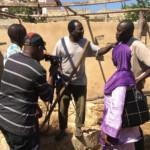
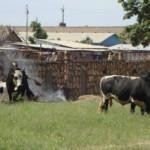
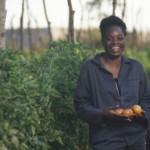


Good insight here, Africa needs this